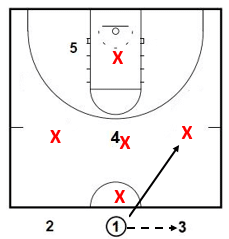
Some thoughts on attacking 1 3 1 half court trap defenses with “Rotation.”
If you are coaching without a shot clock, I don’t mind making the defense run and cover the whole half court for 25 or 30 seconds. I don’t like to pass up good shots, but if we have to make the defense work to the point of where they aren’t having much fun playing the trap, that often helps render it ineffective after a couple of possessions.
This is more principle and spacing based rather than pattern based.
This was designed for a post player who needed to stay in the lane. It won’t work for everyone, but the three player entry is the best way to keep from turning the ball over at the 10 second line that I have seen.
Hopefully you can pick up a couple of principles to apply when you are attacking a 1 3 1 half court trap.
We want to attack the trap to score, not to just keep from losing the ball.
Always have three available receivers 15 feet from the ball and 15 feet apart from each other. Available to the ball means where the player with the ball can see you and can pass to you. Being unguarded is not enough.
We want to pass the ball to the player in the middle of the defense any time we can.
When the ball is above the free throw line #5 is on the block on the opposite side from ball at all times. He can step to the ball if a release is needed. The number 5 in this diagram is an inside player only. If you have a player who can make plays you can allow him or her more freedom.
Fake a pass to make a pass. Meet every pass.
Always see the basket when you catch the ball. If the defense leaves the basket unguarded to gamble for traps, you need to get a layup.
Our objective is to get the ball in the middle as often as possible and attack from there.
The numbers are just for identification, not as identifying characteristics of the players. The #4 is not necessarily a “Power Forward”
Diagrams created with FastDraw
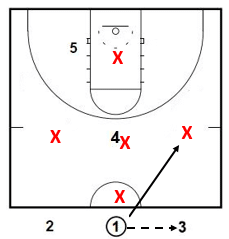
We would rather pass the ball across the time line than dribble it so that the player with the ball has a live dribble when trapped, rather than have a dribbler pick the ball up when trapped. We do have a dribble entry as our last option to get the ball across the timeline and avoid a 10 second count.
1 can pass to either side–in the diagram the pass is made to the right side.
1 then cuts through to the ball side as one of the three available receivers.
It is important that 1 not cut to the sideline, but stays off the sideline when completing the cut.
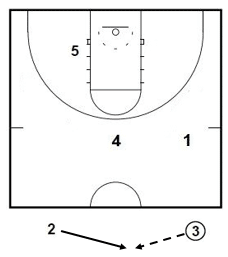
I am going to leave off the defenders in the remaining diagrams. You are going to face different rules for the defense when you are attacking a 1 3 1 half court trap.
2 then replaces 1, not crossing the timeline yet. #4 is the third available receiver. Anytime a player is open in the middle, we want to get it there.
If we can pass to 1 on the cut, we will, but if he is not open pass back to #2.
If #1, and #4 are covered, reverse the ball to #2 who dribbles the ball across as there is no one to trap him and the side he is dribbling to should have no defenders.
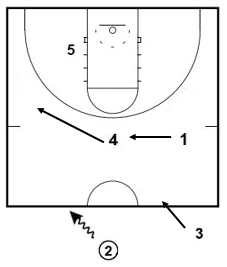
At worst, 2 will be dribbling one on one to get the ball across half court.
Once the ball is across the timeline, everyone crosses the timeline immediately to avoid being in a spot to throw a pass that would result in an over and back violation.
If #4 is open in the middle at any time, we give him the ball. This player must be very active in working to get open in the middle.
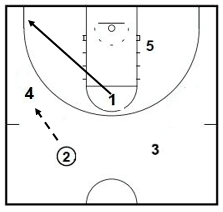
Now 1 is in the middle and the middle player continues to be the top option.
If we can get the ball moving and move the defense, we can use dribble penetration as long as we are not dribbling into traffic and trouble.
If the ball goes to 4 on the wing, 1 cuts through to the corner.
The corner 3 is a great shot against a 1-3-1 trap, but is also a place where you don’t want to get trapped. Only put the basketball in the corner when you have a shot.
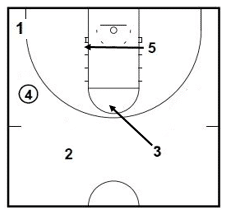
If the ball does go to the corner, 5 will come across to the ball side to set up the 3 available receivers.
The ball can be reversed to the other side (continually working to get the ball to the player in the middle).







Very helpful . I saw some great ideas!